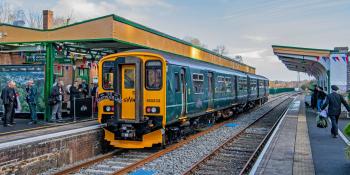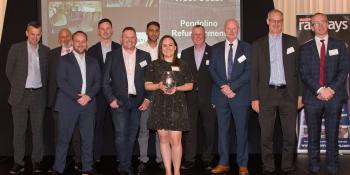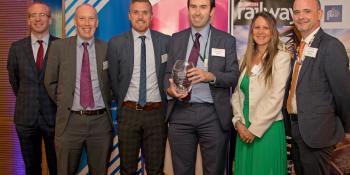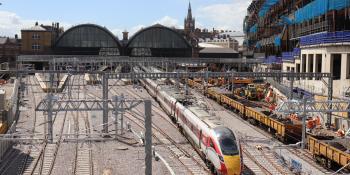Excitement is mounting for the Fourth Friday Club Railway Innovation Awards on 15 October. Modern Railways summarises a selection of entries


FOUR-CHANNEL SPEED SENSOR
Rowe Hankins’ entry is a fourchannel speed sensor which has two independent dual-channel sensors in a single housing and can be used as a direct replacement for single or dual-channel sensors. It’s claimed to improve safety because the four sensor outputs are isolated from each other, meaning that malfunction or failure of a single sensor will not affect the functionality of any of the remaining three channels.
5G-ENABLED TRAM
The first 5g-enabled tram is the subject of an entry by Icomera and West Midlands 5G. A trial installation on a West Midlands Metro tram demonstrates how 5g-connected applications can make use of the technology’s greater data capability to make public transport a safer, more accessible and enjoyable experience for passengers, while being cost-effective for operators.
AUTOMATED VIDEO REVIEW
One Big Circle’s entry is its Automated Intelligent Video Review system, which enables video data to be captured from multiple devices on service and measurement trains and made instantly available securely online for review and analysis. Video data is transmitted via a 4G data connection, removing the need to courier hard drives around. It has been adopted by Transport for Wales, Avanti West Coast and Network Rail.
SUPPORTING APPRENTICES
The first of a series of entries from Govia Thameslink Railway is its apprentice and school leaver programme, which seeks not only to develop skills but to identify potential future leaders. Applications for its four-year engineering apprenticeship have doubled since 2019, and its diversity reach has increased too.
ATO ON ETCS
Network Rail’s pilot scheme to test Automatic Train Operation under European Train Control System could have dramatic ramifications for the railway. A Class 313 EMU was successfully demonstrated on the ETCS integration facility at Hitchin, and the impact could stretch far beyond UK shores.
MORE EFFICIENT TOILETS
The Cleartrak toilet developed by Gbr-rail recycles liquid waste for reuse in flushing and hand washing, and processes solid waste into a biochar, which only needs emptying every three months. It promises to reduce the complex and timeconsuming task of maintaining train toilets and do so more sustainably.
CUTTING CONCRETE WASTE
Cloud Cycle’s real-time and predictive analysis allows ready-mixed concrete suppliers to improve on and replace current manual testing processes, cutting the amount of concrete rejected due to quality concerns. It says the savings on High Speed 2 could total £80 million.
CREATING NEW HABITAT
As part of High Speed 2’s environmental efforts, 138 hectares of calcareous grasslands are being created in the Colne Valley, using material excavated from the Chiltern Tunnels. Align Joint Venture’s project will support hundreds of species of flora and fauna, including insects, birds, mammals, reptiles and amphibians.
SUPPORTING YOUNG PEOPLE
Govia Thameslink Railway’s Kickstart and Get into Railways schemes aim to support young people on Universal Credit and struggling to find work. As well as providing vital work experience and training, the schemes focus on personal development.
RAINFALL ALERTS
Network Rail’s Convective rainfall Alert Tool is a new weather forecast which provides more granular weather information for control rooms than ever before. It alerts staff when predetermined rainfall thresholds are predicted to be breached, allowing them to act before serious incidents occur.
MONITORING RAILS BETTER
Dual Inventive’s entry is its Critical Rail Monitor 3000, which provides remote monitoring of rail temperature and alignment, aiming to reduce the number of failures and delays – and alerting infrastructure maintainers to intervene before serious delays are incurred.

AUGMENTED REALITY
Skanska adopted augmented reality technology to help improve the efficiency of Network Rail’s Interdisciplinary Review process at London Euston. Use of augmented reality allowed visualisation of 3D design models live and on site, helping to improve existing processes.
ENCOURAGING INNOVATION
The Digital Innovation and Collaboration in Engineering competition is an initiative developed by Network Rail to encourage a grass roots reinvention of the way people think and work.
It is aimed at apprentices and graduates and run by them too.
DIGITAL DEPOT PLANNING
Toshiba Digital Consulting has upgraded its digital twin system to apply to depots. The model precisely represents a depot’s physical layout and movements based on local rules. Artificial intelligence can propose optimised shunting and stabling plans to help improve the efficiency of operations.
UPDATING POSSESSION MANAGEMENT
In a bid to improve the safety and speed of setting up engineering possessions, Network Rail’s R&D Accelerated Innovations Team has developed a digital possession management system. It delivers a safer environment for track workers, as well as saving time in setting up and managing possessions.
AUTOMATED RAIL HEAD REPAIRS
Cutting edge technology has been developed by Network Rail to automate the repair of rail head defects. The Rapid Automated Repair of Rail Head Defects system can fully automate repairs and fix a defect in 30 minutes. A prototype has been developed, and it is being adapted for cast and fabricated crossings to increase the number of repairs that can be addressed.
INCREASING DIVERSITY
Govia Thameslink Railway has made a concerted effort to increase the diversity of its workforce, and particularly to attract more women to the rail sector. An example of success is that the number of female applicants for train driver positions almost doubled from 413 in 2019 to 825 in 2020.
EAST COAST AMBASSADORS
A new way into rail for young people is Gtr’s East Coast Ambassador programme, developed to support the East Coast Upgrade. All the team have now moved on to management roles, jobs elsewhere in the industry or to further education.
MONITORING EARTHWORKS
High Speed 2 contractor Align has worked with Cambridge University’s Centre for Smart Infrastructure and Construction to develop a new way of monitoring earthworks. It uses fibre optic cables in a geogrid, providing a low-cost system that can by applied to kilometres of earthworks to detect ground movement.
FLOWING FOOTBRIDGE
In a bid to make closing foot crossings easier, Network Rail has developed the FLOW footbridge design. It uses a temporary and then a permanent structural spine with deck units clamped onto it. The design offers flexibility in build, easy construction, and integrated monitoring at half the weight of a traditional steel footbridge.
LOW MAINTENANCE FOOTBRIDGES
Taziker’s fibre reinforced plastic footbridge design is quick to install, affordable and has a low carbon footprint and lower ongoing maintenance requirements.
HYDROGEN SHUNTERS
Vanguard Sustainable Transport Solutions believes hydrogen offers a zero-emission way of providing shunting locomotives for depots and yards. It is converting a Class 08 shunter to hydrogen-hybrid operation as a test vehicle.
AWARD CATEGORIES
■ Engineering and Safety
■ Environment and Sustainability
■ Passenger Experience
■ Cross-industry Partnership
■ Operations and Performance
■ People, Skills and Diversity
■ Small Scale Project
■ Large Project
IN PARTNERSHIP WITH

SPONSORED BY
www.keymodernrailways.com October 2021 Modern Railways 61

CUTTING FREIGHT CARBON
Freight operator DB Cargo is introducing new Hydro-treated Vegetable Oil fuel which could cut CO2 emissions by up to 90% compared with standard diesel. If successful, it will make the most sustainable mode of freight even more so.
INCUBATING INNOVATION
Transport for Wales’ Innovation Lab is a 12-week accelerator programme run in partnership with Alt Labs to tackle ‘problem statements’ and challenges across the business. Start-ups collaborate with mentors to refine and develop products for the rail industry and wider transport sector – with ideas pitched to Tfw Rail to choose whether to invest further.
INTELLIGENT INFRASTRUCTURE
Network Rail’s Intelligent Infrastructure programme aims to target maintenance interventions in the ‘right place at the right time’. Its entry focuses on the geographically diverse team and delivery partners and how they work together collaboratively in the UK, India and other countries. The programme is said to be ‘revolutionising’ the way NR operates the network.
JUMBO TRAINS
Some of the best innovation involves using what you have better, and this is certainly the case with Freightliner’s ‘jumbo’ trains, which have seen train loads of aggregates and construction materials from the Peak District increase in weight from 2,400 tonnes to up to 4,200, increasing the efficiency of operation, reducing network footprint and enhancing rail freight’s environmental credentials further.
KINETIC PAVING
London Northwestern Railway has taken advantage of new technology to harness passengers’ footsteps to create electricity at Leighton Buzzard station.
The power is used to feed local charging points, reducing energy consumption and carbon emissions as passengers use the station.
REMODELLING KING’S CROSS
The successful remodelling of London King’s Cross station is a textbook example of how good planning and collaborative working can bring success. Despite the impact of the pandemic, Network Rail and industry partners have delivered a project which has provided much-needed capacity at this important station.
KNOW YOUR TRAIN
Occasional passengers can find it difficult to know where their seat and onboard facilities are. Realtime Trains’ Know Your Train feature provides information on a train’s length, formation and facilities, backed by visual imagery to help passengers travel with confidence.
TRAVEL PERKS
In a bid to encourage more repeat travel, Lner’s Perks scheme was developed. It offers rewards for joining, discounts on journeys and a host of member benefits for users with the mobile app. It is proving highly successful as passengers return to the railway after the pandemic.
ENHANCING LUMINATE
Resonate’s Luminate Traffic Management System has proved a success, and the latest developments now include crew and stock information to improve operational management. It can flag risks of crew being out of position, highlight unallocated crew or stock which could be allocated to a service, and warn of platform length issues. It is being used by Network Rail’s Western Route and Great Western Railway.
MOBILE STATION MANAGERS
In a bid to keep passengers informed and moving during the East Coast Upgrade, Govia Thameslink Railway recruited customer service experts from outside the railway to support station staff at key locations. The Mobile Station Managers played a vital role in assisting teams throughout the programme.
PREDICTING OLE ISSUES
In a bid to reduce the amount of manual surveying of overhead line equipment, Network Rail’s OLE- Stat system uses data collected by New Measurement Trains and applies complex algorithms to determine faults by spotting differences between what should be there and what is. It is expected to make a return on investment in just two years from maintenance and surveying savings.
IMPROVING ON-CALL
Managing on-call incidents can be a challenge, particularly during traumatic incidents. Govia Thameslink Railway’s Operation Watershed took a system-wide approach to reviewing processes and changing the way on-call incidents are managed and communicated. The results are faster responses, more informed decision-making and improved support for staff.
BETTER BRIDGE MANAGEMENT
Network Rail’s panoptic approach to bridge management creates a digital twin of bridge structures and flags defects using multiple sources of data. It allows assessments to be made off-site and reduces disruption to train services.
PUTTING PEOPLE FIRST
Sheffield-based consultancy 3squared is placing people at the heart of its business. As well as supporting its staff, it also works closely with the surrounding community to nurture emerging talent and provide new career opportunities in the rail and technology sectors.
TREATING SLURRY CLEANLY
Treating tunnelling slurry is a major challenge for High Speed 2 contractors. Align JV is researching and trialling potential polymers to replace the hydrated lime additive conventionally used in treating it – saving money and reducing the carbon footprint of the process.
PREVENTING TRAM OVERSPEEDS
DB ESG and Sella Controls have developed the Physical Prevention of Overspeeding system to prevent trams exceeding speed limits at predetermined locations.
It is reckoned to be the first such system in the world which can be applied to light rail.
FORECASTING CROWDING
The Rail Demand Information System is the result of the efforts of a consortium led by RASIC to help forecast train demand and crowding to allow operators to manage services in response to real-time demand, reducing overcrowding at stations and on trains, as well as providing more efficient resource planning.
MAXIMISING POTENTIAL
The Railsmart Employee Development System by 3squared is now being widely used across the rail network. It simplifies information management about safety-critical staff, and can help improve operations, reduce incidents and mitigate business risk.
HELPING PASSENGERS FIND SEATS
An innovation from Southeastern is its Seatfinder system which helps passengers identify less crowded areas on trains and get a seat. Since its launch in 2020, it has been rolled out via app and website, and now includes the type and status of on-board toilets and handwashing facilities at stations.
MAKING PASSENGERS SAFER
Network Rail has developed its Security Surveillance Analytics system to help staff identify dangerous situations, criminal behaviour and suicide risk situations before they escalate. It processes CCTV footage and alerts staff of possible situations. It is expected to save around 15,000 delay minutes a year when rolled out across the network, as well as improving safety.
SUPPORTING DISABLED CUSTOMERS
Avanti West Coast is encouraging disabled people to make the most of rail travel by creating a social media forum on Facebook to build an interactive online community for them. In addition to improving customer experience, it is providing important feedback on how to make travel more attractive for disabled passengers.
TRACK DRAINAGE UPGRADES
Civil Water Management’s TDS-400 modular drainage panels have been developed to release hydraulic pressure and allow excess water to flow into drainage systems. It provides greater control of where water is routed and is being considered for tunnels as well as on other parts of the network.

THERMAL MONITORING
Rail Innovations’ Thermal Radiometry cameras have been developed to identify imminent equipment failure from heat build ups. It has been tested in a Scotrail Class 43, and on the lineside to detect hot wheelsets, axle boxes and other underframe equipment.
THALES PREDICTS POINTS
Thales’ TIRIS Points Predict system is designed to provide predictive maintenance of points machines across the rail network and allow staff to intervene before they fail. It uses machine learning and is expected to reduce disruption to trains and make maintenance more efficient.
TRACKING TRAINS PRECISELY
Realtime Trains’ Track Your Train system is designed to provide a simple and easy to understand view of signalling information to passengers and staff and is initially available on some routes out of Liverpool Street.
REALTIME DRAINS
To better manage drainage assets, Network Rail has developed the Trackwater 2.0 system. It uses internet-connected sensors on drainage catch pits, data modelling and predictive analytics to better manage and maintain drainage systems, reducing disruption and saving money.
SERVING PARTIALLY SIGHTED
Gomedia’s Transport Accessibility solution is designed to provide timely and accurate information to partially sighted passengers who need additional assistance. It uses smartphones to recognise special codes and provides information visually and audibly to them. Initially trialled on the West Midlands Metro, it will soon be tested by Avanti West Coast.
CONNECTING THE MIDLANDS
The West Midlands Rail Programme’s entry reflects the strong partnership working between rail operators, Network Rail, West Midlands Rail Executive, Transport for West Midlands and principal contractors to deliver a suite of upgrades across the region, including enhancements at University and Perry Barr stations.

INTERACTIVE JOURNEYS
To make journeys more enjoyable for passengers, Window Seater has developed a web-based content platform which integrates local stories with travel applications, on-board entertainment and ticketing to provide information about locations a train is passing. It is working with the Community Rail Network with the support of Great Western Railway, and 10 guides will be available from January 2022.
A HIGH-RES NETWORK
Network Rail says a winter aerial survey of the entire network provides more detail and clarity than on any other railway in the world. Using the latest camera and 3D technology, it provides a desktop capability for engineers and planners to carry out planning from their offices.
TRACKING CONCERNS
In a bid to understand passenger concerns better, Transport for Wales collaborated with Wordnerds to track social media comments and identify their priorities. Early trials highlighted concerns about compliance with mask wearing, and having been made aware of the issues, Tfw was able to act to increase it.
CAPTURING RENEWALS DATA
Intoware’s Workfloplus platform has been developed for Network Rail to improve the capture and use of data on renewals projects. It should speed the collection and collation of data, improve its quality and have an impact on safety and efficiency.
GOING ‘CARBON POSITIVE’
Network Rail Southern Region went beyond merely making the refurbished Denmark Hill station carbon-neutral in operation: by using a Uk-manufactured lightweight photovoltaic film on roof surfaces at the station, it generates more electricity than the station uses, returning power to the Grid.
GAUGING INTEREST
New software from D/gauge could transform the ease and effectiveness of assessing gauge clearance for rolling stock. A cloud-based solution with an easy-to-use interface, its outputs can be imported into design software to engineers to incorporate its analysis into infrastructure design.
DETECTING EARTHWORKS ISSUES
Findlay Irvine’s sensor-based system enables infrastructure managers to monitor earthworks for signs of movement, to warn engineers before critical failures happen and reduce the number of manual inspections needed at vulnerable locations.
RECYCLING PHONES
With large numbers of people using railway stations, Merseyrail is working with technology company ECOATM to provide passengers with a fast and accessible way of recycling old mobile phones in return for rapid payment – helping to reduce the growing impact of technology waste.
GA REDUCES IMPACT
Greater Anglia’s entry is focused on its energy and environment strategy, which has seen the operator reduce energy usage, improve the efficiency of operations and maximise rail’s role in the sustainable development of its region.

MORE SUSTAINABLE FREIGHT
As calls grow for modal shift of freight from road to rail, Freightliner’s latest FFA-G intermodal wagons are set to enhance the sector’s environmental credentials further. It provides full W10 clearance with low track force bogies and a claimed class-leading tare weight of 18.5 tonnes – cutting power consumption by locomotives and reducing track wear.
AFFORDABLE BI-MODES
Porterbrook’s repurposed FLEX bi-mode Class 319 Emus are intended from the outset to provide an environmentally and financially efficient way of reducing the amount of diesel usage on electric lines, at a lower carbon footprint than new or diesel-only trains. The battery-diesel Hybridflex is the subject of a separate entry which boasts even greener performance on non-electrified lines.
PREDICTING ASSET FAULTS
It is always better to repair a fault before it becomes critical, and this is the purpose of Network Rail’s Intelligent Infrastructure Team’s Insight system. It allows track teams on routes to access all the information they need from a single digital source to carry out the right work, at the right time, in the right place – improving efficiency as well as safety.
RETRAINING ALL DRIVERS
Greater Anglia’s whole-fleet replacement programme created a huge challenge in training its drivers on new trains without disrupting existing services.
Extensive and robust planning ensured that even during the pandemic, not a single train has been delayed due to a lack of drivers.
PROJECT HORIZON
Faced with frequent timetable changes during the pandemic, LNER developed its Horizon system to ensure passengers could book tickets up to 12 weeks in advance, update bookings if needed, and allow passengers to obtain a full refund or rebook if the revised journey was unsuitable. It could allow even longer booking windows in the future.
CUTTING ELECTRIFICATION COSTS
Siemens Mobility and the Rail Electrification Alliance have successfully delivered Phase 2 of the ECML power supply upgrade, with more than £500 million saved by using air insulated switchgear and static frequency converter technology compared with traditional solutions. Not only did this save money, it also accelerated completion of the programme.
TRAINING REVOLUTION
SLC Operations Ltd’s The Rail Academy is aimed at training drivers differently. It brings together rail professionals with experts in virtual reality, 3D and digital technology to deliver improvements to driver training and learning.
STEPPING INTO STEM
Encouraging young people into the railway is vital, and Network Rail and industry partners held a free day of science, technology, engineering and maths activities in August to do just that. It proved popular with children and families and might just have encouraged future railway engineers.
COSTAIN’S LIVING LAB
Costain’s TIES Living Lab aims at consolidating and accessing ‘siloed’ data in the industry. Improving the way projects are set up and helping organisations to assess strategic choice and trade-offs, at its heart is an Intelligent Infrastructure Control Centre which links users and data from a range of sources.
UNDERSTANDING PASSENGER MOVEMENTS
The Covid pandemic has highlighted how important smooth and safe passenger flows are in stations. CCD Design & Ergonomics and WSP were commissioned by High Speed 2 to test proposed configurations of Old Oak Common station using virtual reality, eye-tracking and emotion-sensing technology.
RAILWAY INNOVATION AWARDS JUDGING PANEL

■ Chair: David Clarke – Technical Director, Railway Industry Association (pictured)
■ Kelvin Davies – Innovation Lead, Rail, Innovate UK
■ Ben Ford – Technology and Innovation Manager, Network Rail
■ Adeline Ginn – Chair, Women in Rail
■ Jo Lewington – Chief Environment and Sustainability Officer, Network Rail
■ Chandra Morbey – Innovation and Projects Director, Porterbrook
■ Michelle Roles – Stakeholder Manager Wales, Transport Focus
■ Phil Sherratt – Editor, Modern Railways
■ Helen Waters – Associate Director, Steer




